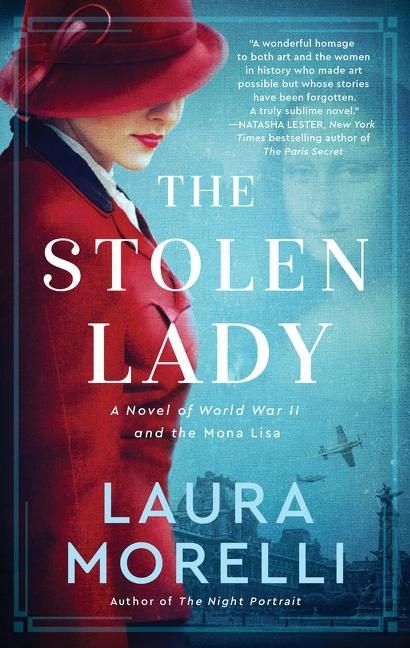
THE STOLEN LADY
A Novel of World War II and the Mona Lisa
From the acclaimed author of The Night Portrait comes a stunning historical novel about two women, separated by five hundred years, who each hide Leonardo da Vinci’s Mona Lisa—with unintended consequences.
France, 1939
At the dawn of World War II, Anne Guichard, a young archivist employed at the Louvre, arrives home to find her brother missing. While she works to discover his whereabouts, refugees begin flooding into Paris and German artillery fire rattles the city. Once they reach the city, the Nazis will stop at nothing to get their hands on the Louvre’s art collection.
From the acclaimed author of The Night Portrait comes a stunning historical novel about two women, separated by five hundred years, who each hide Leonardo da Vinci’s Mona Lisa—with unintended consequences.
France, 1939
At the dawn of World War II, Anne Guichard, a young archivist employed at the Louvre, arrives home to find her brother missing. While she works to discover his whereabouts, refugees begin flooding into Paris and German artillery fire rattles the city. Once they reach the city, the Nazis will stop at nothing to get their hands on the Louvre’s art collection. Anne is quickly sent to the Castle of Chambord, where the Louvre’s most precious artworks—including the Mona Lisa—are being transferred to ensure their safety. With the Germans hard on their heels, Anne frantically moves the Mona Lisa and other treasures again and again in an elaborate game of hide and seek. As the threat to the masterpieces and her life grows closer, Anne also begins to learn the truth about her brother and the role he plays in this dangerous game.
Florence, 1479
House servant Bellina Sardi’s future seems fixed when she accompanies her newly married mistress, Lisa Gherardini, to her home across the Arno. Lisa’s husband, a prosperous silk merchant, is aligned with the powerful Medici, his home filled with luxuries and treasures. But soon, Bellina finds herself bewitched by a charismatic monk who has urged Florentines to rise up against the Medici and to empty their homes of the riches and jewels her new employer prizes. When Master Leonardo da Vinci is commissioned to paint a portrait of Lisa, Bellina finds herself tasked with hiding an impossible secret.
When art and war collide, Leonardo da Vinci, his beautiful subject Lisa, and the portrait find themselves in the crosshairs of history.
- William Morrow Paperbacks
- Paperback
- September 2021
- 512 Pages
- 9780062993595
About Laura Morelli
Praise
“Like the masterpiece she writes about, Laura Morelli has created a work of art that is impossible to forget. With beautifully rendered settings, expertly drawn characters and a storyline that immersed me from the very first page, The Stolen Lady is a wonderful homage to both art and the women in history who made art possible, but whose stories have been forgotten. A truly sublime novel.”–Natasha Lester, New York Times bestselling author of The Paris Secret
“The Stolen Lady is a beautifully written, must-read story of the incredible journey of the Mona Lisa set amid two turbulent times in history. Laura Morelli offers a well-researched and richly told tale that captivated my attention from the first page.”–Madeline Martin, New York Times bestselling author of The Last Bookshop in London
“If you liked Laura’s Morelli’s The Night Portrait, you’ll love The Stolen Lady. Morelli once again spins an unforgettable, page-turning tale of art history—this time about Leonardo da Vinci’s The Mona Lisa. With exquisite historical details, surprising plot twists, and unforgettable characters who commit extraordinary acts of bravery to create and protect art, The Stolen Lady entertains while giving readers a whole new perspective on the world’s most famous painting.”–Stephanie Storey, bestselling author of Oil and Marble: A Novel of Leonardo & Michelangelo and Raphael, Painter in Rome
Discussion Questions
1. Leonardo da Vinci’s portrait of the Mona Lisa stands at the center of this story. Before reading The Stolen Lady, what preconceptions did you have about this portrait? How has your appreciation of this painting changed since reading this story? What do you think is special about this portrait, and why do you think it’s so famous?
2. Anne begins with the belief that she’s “just a typist,” but she ends the story by playing a critical role in the fate of the Louvre’s works of art. At what point does Anne make a shift toward a more active role in saving the Louvre’s works of art? What other choices do you think she might have had? What choice do you think you would make in a similar situation?
3. Throughout the novel, Bellina walks a thin line between protecting her mistress and putting the family at risk. How do you think Bellina navigated the narrow set of choices a servant woman might have had in Renaissance Florence? How might things have turned out differently for her if her indiscretions had been discovered?
4. Bellina wrestles with how luxurious material goods might be considered sinful or a force for good. Can you think of other examples in our contemporary society where people must weigh a similar question?
5. How have Bellina’s, Lisa’s, and Anne’s upbringings prepared them—or not—for the trials and tribulations they face in this story?
6. Leonardo da Vinci spent much of his professional life striving to be a great inventor and engineer, while history remembers him first and foremost as a painter. Why do you think this is? Do you think he would be surprised to learn that his Mona Lisa is the most famous painting in the world?
7. Why do you think Bellina decides to hide Lisa’s portrait? What does she risk? Would you have done the same? Why or why not?
8. How do the themes of hiding and secrets weave throughout the story? What are each of the main characters—Anne, Bellina, Leonardo, and Lisa—hiding from others? What are they hiding from themselves?
9. How much freedom do Bellina and Anne have to make choices about their own futures? What are the constraints on their choices, and how do they navigate these barriers given the circumstances of the times in which they lived?
10. What parallels did you draw between characters in Renaissance Florence and those in World War II France?
11. In the Renaissance story line, the French are the invaders, while in the World War II story line, the French themselves are invaded. In the midst of war and political turmoil, what is the role of art? How does art retain its value when so many human lives are on the line?
12. In this story, what is “stolen” and who is the thief?
Excerpt
Part 1
Hidden
Leonardo
Florence, Italy
1472
My master tells me I’m no good at finishing what I start. It’s become a problem.
Through the high, narrow windows of Master Verrocchio’s workshop, I watch the summer evening sky turn its tawny shade of gold. Inside, the air is stifling and heavy with dust. The other apprentices have cleaned their brushes and arranged the day’s sketches into neat stacks before leaving for the taverns, their stomachs rumbling and their tunics stained with paint. Master and I are the only ones left. I feel his beady eyes on me as a single drop of sweat licks the small of my back.
In the silence, I watch the flecked glow brighten the dim corners of the workshop. Suddenly, a magical crepuscular light pours through the window, illuminating the crumbling stucco walls as if gilding them. The light streaks across our panel in progress. I hold my wet fox hair brush in midair and survey our work.
Many weeks ago, Master Verrocchio completed the figure of the Virgin Mary and the magnificent, winged archangel who has swooped down from the heavens to kneel before her with a lily in his hand. I focus on the distant background, where I’ve outlined trees, mountains, and valleys receding into the distance. My master relies on the same tempera pigments his grandfather used, but I have begun to mix oil into my colors. I squint and consider the slick, wet haze behind the figures. Master has made Our Lady’s arm too long, her hair disarrayed. But I don’t say this aloud.
The monks are waiting, my master has said; he’s said it more times than I can count. They’ve been waiting patiently for this promised altarpiece. Months have turned into a year.
My father is waiting, too. He’s waiting for me to make something of myself. As usual, I have fallen short.
From across the studio, I feel Master Verrocchio’s gaze burn into my back. I pretend to study the delicate flowers in the foreground—I painted them months ago—and judge whether I should add another layer of varnish over this flourishing enclosed garden, the hortus conclusus that symbolizes Our Lady’s purity.
This is the last time I finish a painting for Master Verrocchio. I am nearly twenty years old now. Old enough to establish a workshop of my own. Young enough for my life to stretch before me, full of chances for the contraptions in my sketchbooks to become real. Armored carriages. Portable trebuchets that collapse with the turn of a lever. A flying machine with wings like a bat’s. Beyond this workshop, beyond painting, perhaps even beyond Florence, opportunities lie yet untapped.
Suddenly, Master Verrocchio approaches me in the same way as the archangel, swooping in like a great bird of prey. Commanding. Full of important news. Just like Our Lady, for a moment I grasp the collar of my tunic and recoil. I cannot meet his eyes, so I set my gaze instead on the beautiful, serene face of Our Lady and wait for his words.
But my master says nothing. For a moment, the two of us stare at the panel.
Then he peers over my shoulder at my patch of wet paint and frowns. A reaction to my work or force of habit? I will never know.
Hmm. My master grunts finally, then turns away.
Yes. It’s better if I leave Florence.
Surely there is more to life than painting portraits of beautiful ladies. But I do not say this aloud, either.
In the end, we are all hiding something.

 Laura Morelli holds a Ph.D. in art history from Yale University and is an award-winning, USA Today bestselling historical novelist. Laura has taught college students in the U.S. and in Italy. She has covered art and authentic travel for TED-Ed, National Geographic Traveler, Italy Magazine, CNN Radio, and other media. Laura is the author of the popular Authentic Arts guidebook series that includes Made in Italy. Her historical novels, including The Night Portrait and The Gondola Maker, bring the stories of art history to life.
Laura Morelli holds a Ph.D. in art history from Yale University and is an award-winning, USA Today bestselling historical novelist. Laura has taught college students in the U.S. and in Italy. She has covered art and authentic travel for TED-Ed, National Geographic Traveler, Italy Magazine, CNN Radio, and other media. Laura is the author of the popular Authentic Arts guidebook series that includes Made in Italy. Her historical novels, including The Night Portrait and The Gondola Maker, bring the stories of art history to life.